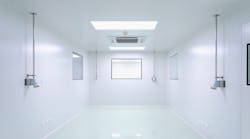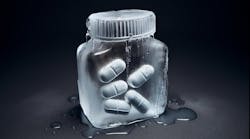With liquid-filled vial nasal delivery devices gaining momentum and market share as an efficient, user-centric drug delivery platform, an inevitable obstacle is automating processes historically performed either partially or completely manually. The concept-to-completion process of bringing viable nasal devices to market has several potential pain points.
One hurdle is ensuring that detailed vial inspection and final device assembly can keep pace with upstream fill-finishing processes, causing a challenging bottleneck. Additionally, vial fill-finish operations in these settings bring their own inherent issues, most notably dosing precision and repeatability for what is often a miniscule amount of drug product.
With such a diverse range of complex steps, preventing production line bottlenecks and ensuring through-process quality become keys to automation and the increased output it allows.
This article discusses step-by-step best practices for automating nasal devices whose primary packaging consists of liquid-filled vials — an increasingly attractive delivery system where solutions for high-volume automation are sought-after, with prominent examples including (but not limited to) the dramatic surge in production for the opioid overdose-reversing drug naloxone.
Nasal device automation, step by step
Until very recently, instances where the up-levelled technology needs of liquid-filled vial nasal delivery devices were squared with attendant equipment engineering expertise were few and far between.
However, utilizing such features as racetrack formats and multiple lane construction, it has become more feasible to develop comprehensive automatic filling and assembly solutions that meet these devices’ rigorous manufacturing requirements, while dramatically increasing the number of nasal devices produced per minute. Crucially, these machines also can be designed to fit in a footprint whose compactness reflects the premium placed on cleanroom floor space.
Considering the delicate handling and intricate maneuvers these machines must perform, this marriage of precision and proliferation represents a quantum leap forward — and opens new and necessary avenues for this platform’s market share growth and overall expansion.
It cannot be understated how truly painstaking the liquid-filled vial nasal device production process can be. To understand that, it’s useful to revert to the research and development (R&D) stages, where such delivery systems are produced using successive semi-automatic benchtop-assisted steps, from filling and inspecting to assembling and final packaging. This arduous, multistep approach generally yields no more than a handful of finished products per minute. Such a setup is workable for R&D stages, but completely unviable — economically or otherwise — for commercialization purposes.
To fully showcase the need for automation, it’s important to start at the beginning of the process. Right from the inspection of yet-to-be-filled vials, it’s clear that automation is not only a preferred production method in this format but, given the volume needed for commercial viability and supply continuity, is entirely necessary to forge a reasonably workable process. A station-to-station review, through the steps performed by today’s next-generation automatic liquid-filled vial nasal device assembly equipment, is critical to understanding the value of automation.
While machines for this purpose can exhibit a variety of different features, for the sake of streamlining our discussion let’s home in on a setup that is becoming increasingly sought-after: an inline, synchronous motor-enabled racetrack system, whose attributes include integrated 360-degree high-resolution camera inspection, valve-less ceramic piston fillers, state-of-the-art assembly functions and — to suit regulatory requirements and promote continuous production improvements — sufficient data collection capabilities.
These are the building block components that, when combined and aligned, can produce the type of exactingly filled and meticulously metering nasal devices required in healthcare settings.
The first stage involves the inspection of unfilled vials. After an air jet and vacuum system cleans all vials, the system’s initial inspection station checks for cracks or other physical defects in each container. To perform this step, vials are raised and rotated allowing 360-degree, high-resolution cameras to leave no section uninspected. The machine also can be equipped with a variety of additional downstream inspection capabilities, including safeguards checking for unstoppered vials, an enhanced lens for exacting fill height verification, and a push-pull station that tests the nasal device’s integrity.
With cosmetic inspection compete, vials are filled via a series of precision valveless ceramic piston fillers, whose volume can be set and calibrated electronically at an independent, portable cart complete with its own Human-Machine Interface (HMI) setup; the cart is then reconnected to the larger automatic machinery platform.
While the primary inspection for fill volume is performed by cameras at a subsequent station, at this stage an intermittent checkweigher can be employed that diverts a handful of vials at a time, recording their weight for an added layer of upstream quality control and verification. Stoppers are then inserted using a servo-controlled pick-and-place module featuring a burping tube to allow air escape during placement. Notably, the depth of placement in this step must be particularly precise.
The next stage is what can be referred to as primary inspection. The machine lifts the now-filled vials, rotating them 360 degrees, while checking for product fill height, stopper height, and any piston placement anomalies such as liquid droplets between fins — as well as foreign body particulates in the drug itself. Next, vials are carefully placed into the vial holders and tamped and placed at a predetermined force that is verified via sensor.
Next, one final visual check of the vial rim is conducted prior to actuator placement. These nasal actuators are introduced in-line via a vibratory feeder, and inspected to ensure cannulae are both present and straight. The nasal devices are automatically placed around the vials, pressed into place with an automatic tamping system which, like the initial vial holder placement, is verified via force gauge. The next inspection stage is physical: a process that gently tugs on the vial holder to confirm it is firmly affixed to the actuator and exhibits qualities robust enough to perform its intended use properties.
The completed device is now ready for labeling and is automatically transitioned to a dedicated labeling station with requisite serialization capabilities. Each label also is inspected for print legibility, then again post-adherence to ensure no label-less products enter the marketplace.
Clearly, all this encompasses an abundance of moving parts that must move in perfect synchronization. It’s also important to understand the level of dosing precision required. Since nasal devices nearly always deal in exceedingly small doses, automated device fill and assembly must exhibit keen microdosing prowess capable of meeting or exceeding minute accuracy tolerances — for instance, +/-2.5 microliters on a fill volume of 100-125 microliters.
Likewise, the overall device landscape is similarly infinitesimal; for example, stop- per positions generally must be determined down to about 0.3 millimeters to ensure device specifications are fully met. And naturally, cleanliness also is paramount. To bolster sterility, the machine’s product contact parts should be composed of hygienically appropriate materials such as ceramic, 316L stainless steel and Teflon.
Finally, user-friendliness is a necessity in an environment where skilled labor continues to be in short supply. Ideally, an automatic liquid-filled vial nasal device machine will include a large, ergonomic HMI featuring intuitive touchscreen displays for key operator functions like seamless recipe control. Flexibility also is key, meaning an HMI should offer the ability to turn on or off any station or inspection per a particular application’s individual requirements.
To comply with current regulations, such electronics also should provide individual login functions (i.e. electronic signature), audit trails, record retention, and other safeguards that ensure documentation and accountability. In addition, such setups also can be outfitted with metrics monitoring that help document mission-critical steps, predict maintenance needs and improve overall production practices.
Remote access functionality is another popular preference, allowing for original equipment manufacturers to conduct necessary maintenance and unforeseen fixes expediently and accurately. Sophisticated manufacturing machinery requires equally sophisticated personnel training, as well as ongoing collaboration with equipment suppliers. To that end, suppliers that will take the long view by parlaying salesmanship into partnership can help drug manufacturers develop solutions that are truly customized and optimized.
Such customization and optimization will undoubtedly be increasingly in demand, for one simple reason: nasal delivery is highly attractive. Compared with syringes, autopens and other injectables, nasal devices deliver drugs less painfully and more expediently. This latter benefit, speed of drug effectiveness, can be mission-critical in emergency situations, such as those in which naloxone or other life-saving medicines are administered.
The bottom line is that nasal devices are not only here to stay but are bound to become more commonplace. To address the needs of these precision-dependent delivery plat- forms, manufacturers and machinery experts must continue to collaborate, innovate, and demonstrate the value of these manufacturing automation technologies.





